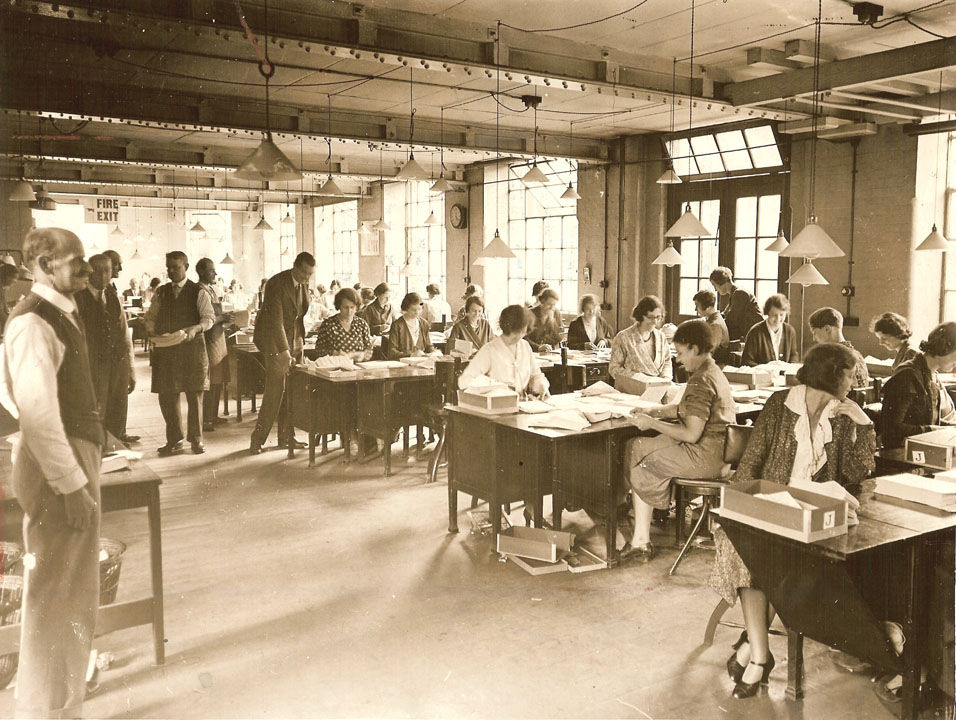Why You Need A Dress Code In Your Workplace
There was a time when a formal dress code was not absolutely needed in businesses, offices and shops - wearing smart attire for work was culturally implied, regardless of the job.
From the Victorian era, right through the first half of the 20th Century, people opted for formality as a matter of course. Even painters & decorators, brickies and factory workers would wear a shirt and tie to work.

Prior to the swinging sixties, it was a time of formality for the average worker, even though they only had a limited supply of outfits.
Now, the culture of fashion has left the word "smart" open to interpretation, and usually meaning expensive, allowing people to wear pretty much what they want to the office. T-shirts, Jeans, patterned shirts... employees seem to have become unaware of what is appropriate for the workplace.
The problem with allowing your staff to wear whatever they want to the office or factory is that it can create a disjointed company brand. This is fine for creative companies, but is it what the average business needs to get ahead in this economy?
A dress code policy in the workplace - formal or informal - can help shape your company culture for the better.
Reasons to create a workplace dress code
We will go into more detail below, but the main reasons for a dress code would be that it makes your workforce look smarter and appropriate for your business, it helps to establish the company brand and ethos within staff, it increases productivity, strengthens team unity, improves pride for workman(woman)ship and the responsibility of each employee.
Not to forget, it has been proven to increase productivity within your workforce.
Read on to learn more about this.
A Smarter Look for Your Team
A dress code does not always mean you need a uniform. Depending on your industry, considering a work uniform is a way for your employees to appear smarter and match your company brand. Even if you do not choose the uniform route, establishing what your staff should and should not wear is a good idea.

In the policy you create, you should outline the looks you would prefer your staff to wear. Many offices suggest that a ‘business casual’ appearance is best. Shirts or Polos Shirts, but not T-Shirts. Trousers or Skirts, but not Jeans or Shorts.
Even with a vague clothing policy, it is important to be specific about what this comprises. Give your employees a realistic idea of what they should wear to appear smart.
Outlines Appropriateness
A dress code can outline office appropriateness and improve focus, but remember that this part of the policy can be difficult.
You should avoid crossing into discriminatory territory such as creating policies that affect only women, or one particular religion - such as no makeup or enforcing skirts or high heels on women - as this is unfair and legally inappropriate.
Make sure your policy lets employees understand what you expect whilst not isolating anyone.
Establishes the Company's Brand
If you create a uniform for your employees, then it is possible to establish a company brand with a dress code. Company colours, logos and ethos can all be woven into the design of your worker's uniform.

A uniform makes employees instantly recognisable should a customer need any help, and improves the first impressions of your company. For a customer based company that is front-facing, having a uniform establishes your company brand and improves relations between your staff and your consumers.
However, it is important to have your employees input on the uniform. You can do this by providing different options and making sure the uniform is stylish, flatters all body types, and is comfortable.
Strengthens Employee Unity and Teamwork
Sports teams and school children wear a uniform because this creates unity. Companies with a dress code promote belonging within their employees. Both a uniform and dress code can make people see they belong in the workplace.
If employees assume they are working towards the same company goals, wearing a unified look, they will be more aligned with company values.
Increases Productivity
Studies show that wearing specific work attire, especially formal clothing, has a positive mental impact on an individual’s productivity. Certain clothing holds symbolic meaning for people, such as wearing an Oxford Shirt and Tie makes people feel ready for business, or a group of employees wearing company branded polos helps them feel part of the same team.
Specific work clothing will make employees more focused on their job and the work they do. Notice how people get changed when they get home. This psychologically important act of changing clothes makes people feel that they are now ‘off duty’ and can relax.

This theory supports the idea we stay more focused when we are wearing work clothes than we do if we dress down. No matter how defined your dress code is, giving your employees a definitive ‘work attire’ impacts their productivity.
Prioritises Safety
Certain industries require PPE and protective clothing to be worn but a uniform policy can establish a safe dress sense even if specialised clothing or equipment is not necessary.
For example, in the hospitality industry, safe dress may include an embroidered apron with a name tag or fob to determine which doors and buildings employees have access to.
In door security work, a formal dress code can help determine staff from the clientele, making it easier (and safer) for everyone.
Outline your uniform policy to highlight safety issues your employees may not consider.
Ensures Pride and Responsibility
Imagine... your employees are all wearing smart clothing, such as a well-tailored suit, and there is someone on your team that is wearing ill-fitting clothing. The sense of pride, responsibility, and company image will be diminished.
Have a workplace dress code to ensure pride and responsibility among your employees. Everyone will know that they represent your company and will wear their uniforms with pride.

Opinions on dress codes and uniforms are mixed in a positive and negative way. Despite this, a workplace dress code establishes any boundaries and/or rules that will make your employees comfortable.
It can be informal by having an unwritten policy flexible to keep your staff happy or formal. You can get your workers on board by outlining an agreed-upon policy.
It is important you do not announce that your employees have to wear a uniform out of the blue. If they are uncomfortable and/or do not want to wear the clothing you provide or enforce, they will become less productive and unhappy - but if you listen to their opinions and include them in the dress code decision making, a dress code will work well for you, for your employees and for the company as a whole.
Conclusion
Having a dress code in place will make your employees look smart and part of a team. Depending on your business objectives, you may want to consider a uniform - whether that's just a Polo or a shirt, or an entire outfit right down to the shoes.
A uniform can help to establish your brand. Involve your staff when choosing a uniform so they are comfortable. This will make them happy and promote pride and responsibility.
Having a dress code can promote belonging and unity. According to studies, specific work clothing will make your employees more focused on their job. When choosing a uniform or creating a dress code, make sure you prioritise your staff’s safety.
Even if you decide on a casual approach, it is important to outline appropriateness of dress in the workplace, but remember not to discriminate.






